Numerous pics here : http://mb770k.canalblog.com/archives.../34487419.html (my blog)
It is through France that begins this world tour of 770 survivors. And more specifically by the Museum Henri Malartre in Rochetaillée sur Saône, near Lyon, where since 1969 is facing a Offener Tourenwagen seized by the Leclerc division Berstechgaden in May 1945.
I must apologize prior to readers: This article is my opinion that one can do worse in the genre! I have only meager information, anecdotes and some photos. Because with the lack of rigor that characterizes to us French, nobody has retained any recollection of the capture of the car (exactly the opposite of our American and Canadian friends, who for their part have rigorously traces the route 770 brought across the Atlantic). My credibility takes a hit at the same time.
This car has a story ... that we know only very partially and try to find out is more a treasure hunt. Along these lines you will understand why under its innocuous appearance (for a 770!), Some little mysteries remain to be elucidated.
The history of the car Rochetaillée begins with history, and even the great history ...
March 1, 1941. Taking Kufra, an oasis in the Libyan desert, the 2nd Armored Division of the one who is still only Colonel Leclerc has won the first French victory since the 1940 disaster With his men, who joined as he General de Gaulle after the invasion of France by the Wehrmacht, he vowed not to disarm before the french flag flies over Strasbourg.
This will be done and after the operations, in early March 1945, the 2nd DB is sent to rest in the area of Chateauroux. The Red Army reached the Oder. Three weeks ago, in Yalta, the political future of Europe took shape without France. It becomes clear that the Allies must move quickly to the east of the Rhine if they want to balance the political divisions in preparation. The rest of the division is quickly perceived as a penance, and Leclerc tirelessly involved at all levels to be sent to Germany.
The order arrived as expected on 22 April. If starting May 2, the Russians have become masters of this symbolic place that is Berlin, Leckerc and his men manage the feat of entering Forty eight hours later, in that other place that is symbolic Berstechgaden. On 5 May 1945, the French colors were hoisted on top of Mount Kehlstein.
We finally known about the conditions of entry of this 770. If not this short report FR3 Lorraine in which, formerly of the 2nd DB, René Grandjean, evokes the arrival of the car and repairs he had to do to get it going again ...
It is also known that Leclerc donated the car to the US general commanding the neighboring sector and the latter left him to Paris in a garage of the Boulevard de Reims before returning to the United States. Bought by a veteran of the 2nd Armored, the 770 continued his career at exhibitions for the benefit of veterans and victims of war until 1969 and its entry in Rochetaillée Museum.
On the following photograph, one can observe that the exhibition material is suspended in Dutch because the 770 was shown in Belgium and the Netherlands.
Postcards were published "in favor of social work and charity" The picture seems retouched because firstly, exit three additional headlights, second registration number seems to have been drawn, and finally the presence apparent top compass, indicate that it has used the photo of another model of the same type, but in coupe F.
Some adventures during the car presentations. In Amsterdam, a visitor grabbed a swastika flags. Continued, the thief had no other resources than diving into the waters of the harbor where the flag disappeared. Elsewhere, the tire valves disappearing, so a relief valve stock followed the car. All who hold an accessory designed for the car of Hitler were for their expenses! Finally, when the exhibition was not far from the German border, they are curious hordes which landed across the Rhine.
Anecdote although this article in a local newspaper in 1952: "The armored car of Hitler exhibited at the fair in Saint-Pol-sur-Ternoise" The magnificent armored car of Hitler who once spread terror in its wake became an object of curiosity. After being used by General Leclerc during the campaigns of Germany and Austria, it now goes from town to town
With A.C.P.G. and their president, Mr. Charles RULENCE Hitler armored car will be Saturday (15 March) in Saint-Pol where fair visitors can admire and visit while filling the fund of aid organizations CAGP This car, 6 meters long and 2 meters 14 wide, weighs 4 tons 700: it is powered by an 8-cylinder engine with turbocharger, which can develop up to 400 hp. Very luxurious, it is further reinforced by plates of 18 mm. Its ice is formed of 7 sheets of glass 47 mm, perfectly safe from bullets. The doors, weighing 500 kg each, are electrically controlled using a button on the dashboard. The headquarters of Hitler is raised 15 cm, because the dictator was small, but did not want to show.
Let us add that this car will be presented on the site of the former Palace of Justice (Place Georges-Graux today), that is to say in front of the new station, and remember, the benefit of A.C.P.G.
Henri Malartre had seen the Mercedes for the first time in Lyon, in the 1950s The vehicle was on the bed of a truck on which the organizers stretched a tarp to shelter the fans. The founder of the automobile museum has from that time, wanted this vehicle appears in his collection. But aware of the difficulty to get it, he could not but admire the postcard he had bought at the exhibition. It is only a decade later, Henry Malartre learn that the car was not "exhibited" and that it was parked at a former prisoner of war in the Paris suburbs. The man did enlarge his house. After heated discussions and especially a very tidy sum of money, the squire won the market. Thus Hitler's parade car came to the museum of Rochetaillée, June 26, 1969 along with the exposure matérial (this time written in French)
Just in the small mysteries of Rochetaillée 770 ...
To you it was used by the Führer?
You will observe that so far I have not spoken of Adolf Hitler. And for good reason! In the present state of my knowledge, I have very few tangible elements, if not the presence of a front seat raised 12 centimeters and a grab handle at the top of the windshield, characteristic elements of the car that was used by the Führer (which was invariably seated in the front right). Magnet Do not make mere assertions truth, I prefer to say "we can reasonably think that this 770 was one of the vehicles used by Adolf Hitler"
The other element that intrigues me is that there is to my knowledge, no photograph of the car in position (ie with Hitler on board). While many photographs are supposed to reproduce this car at official events, and even the registration number is the same, the car is different. Indeed, the same number could be reassigned to after a change of vehicle.
Here are ailelurs false-true AI-103708, a 540K-type W24, photographed in Breslau in 1936. Now the car Rochetaillée is a 770k-type W150 and therefore subsequent to 1938.
Dating?
The Director of the museum has kindly sent me some information
The car museum carries the engine number 189 789 corresponding to the command 297 465 of 22 July 1938 it was delivered to the Chancellery of the Reich in the summer of 1939 and bore the body number 849 503 according to the records of the brand; the same car has a different body number, 863 802 corresponding to the command 399 777; the chassis number has disappeared (at least the corresponding plate on the firewall)
I contacted the manufacturer who kindly answered me he gave no information outside the legal owner of the vehicle; I forwarded this information and the coordinates of the resource person to the Director of the Museum so that it can solve this problem of identification.
For now I am at the stage of conjecture and here's the analysis I propose:
This is a 1938-1939 model, probably the first of the series. The proof is provided by this photo. This is the same car a few details such as the front bumper double-blade from the previous series (w 07)
In 1942, following the assassination of Heydrich, who was traveling without escort aboard a Mercedes discovery and unshielded, it was decided to equip dignitaries vehicles ensuring maximum safety: the map " Aktion P "(P for Panzerte or shield).
770 of interest is then recarossée to be shielded, which explains that the body number is different. Similarly, we note the presence of three door hinges against two usually, indicating a level of shielding 2 (as the car of the Canadian War Museum has only two hinges a level 1 shield).
She won, crossing the external defroster vents at the base of the windshield (defrost inside impossible due to the thickness of glass = 40 to 45 mm)
The mystery of the bumper!
As you can observe 770 of Rochetaillée has a bumper-strip with a rubber protection, but without the vertical bananas that are found on all other W150.
R. Bouchardon in his article quoted above (a dictator for five tons of steel), evokes minor repairs carried out after the war, including replacing the front bumper missing.
Similarly, a video shows the car with this original bimetal: https://youtu.be/_ipDzqVB5AE?t=57s
The mystery of the license plate!
All 770 of the Chancellery éteient registered in IA-148 XXX. Or it is IA-103 XXX
The absence of light Notek!
As you can appreciate, we still have much to learn about our 770 ...
(http://mb770k.canalblog.com/archives.../34487419.html)
It is through France that begins this world tour of 770 survivors. And more specifically by the Museum Henri Malartre in Rochetaillée sur Saône, near Lyon, where since 1969 is facing a Offener Tourenwagen seized by the Leclerc division Berstechgaden in May 1945.
I must apologize prior to readers: This article is my opinion that one can do worse in the genre! I have only meager information, anecdotes and some photos. Because with the lack of rigor that characterizes to us French, nobody has retained any recollection of the capture of the car (exactly the opposite of our American and Canadian friends, who for their part have rigorously traces the route 770 brought across the Atlantic). My credibility takes a hit at the same time.
This car has a story ... that we know only very partially and try to find out is more a treasure hunt. Along these lines you will understand why under its innocuous appearance (for a 770!), Some little mysteries remain to be elucidated.
The history of the car Rochetaillée begins with history, and even the great history ...
March 1, 1941. Taking Kufra, an oasis in the Libyan desert, the 2nd Armored Division of the one who is still only Colonel Leclerc has won the first French victory since the 1940 disaster With his men, who joined as he General de Gaulle after the invasion of France by the Wehrmacht, he vowed not to disarm before the french flag flies over Strasbourg.
This will be done and after the operations, in early March 1945, the 2nd DB is sent to rest in the area of Chateauroux. The Red Army reached the Oder. Three weeks ago, in Yalta, the political future of Europe took shape without France. It becomes clear that the Allies must move quickly to the east of the Rhine if they want to balance the political divisions in preparation. The rest of the division is quickly perceived as a penance, and Leclerc tirelessly involved at all levels to be sent to Germany.
The order arrived as expected on 22 April. If starting May 2, the Russians have become masters of this symbolic place that is Berlin, Leckerc and his men manage the feat of entering Forty eight hours later, in that other place that is symbolic Berstechgaden. On 5 May 1945, the French colors were hoisted on top of Mount Kehlstein.
We finally known about the conditions of entry of this 770. If not this short report FR3 Lorraine in which, formerly of the 2nd DB, René Grandjean, evokes the arrival of the car and repairs he had to do to get it going again ...
It is also known that Leclerc donated the car to the US general commanding the neighboring sector and the latter left him to Paris in a garage of the Boulevard de Reims before returning to the United States. Bought by a veteran of the 2nd Armored, the 770 continued his career at exhibitions for the benefit of veterans and victims of war until 1969 and its entry in Rochetaillée Museum.
On the following photograph, one can observe that the exhibition material is suspended in Dutch because the 770 was shown in Belgium and the Netherlands.
Postcards were published "in favor of social work and charity" The picture seems retouched because firstly, exit three additional headlights, second registration number seems to have been drawn, and finally the presence apparent top compass, indicate that it has used the photo of another model of the same type, but in coupe F.
Some adventures during the car presentations. In Amsterdam, a visitor grabbed a swastika flags. Continued, the thief had no other resources than diving into the waters of the harbor where the flag disappeared. Elsewhere, the tire valves disappearing, so a relief valve stock followed the car. All who hold an accessory designed for the car of Hitler were for their expenses! Finally, when the exhibition was not far from the German border, they are curious hordes which landed across the Rhine.
Anecdote although this article in a local newspaper in 1952: "The armored car of Hitler exhibited at the fair in Saint-Pol-sur-Ternoise" The magnificent armored car of Hitler who once spread terror in its wake became an object of curiosity. After being used by General Leclerc during the campaigns of Germany and Austria, it now goes from town to town
With A.C.P.G. and their president, Mr. Charles RULENCE Hitler armored car will be Saturday (15 March) in Saint-Pol where fair visitors can admire and visit while filling the fund of aid organizations CAGP This car, 6 meters long and 2 meters 14 wide, weighs 4 tons 700: it is powered by an 8-cylinder engine with turbocharger, which can develop up to 400 hp. Very luxurious, it is further reinforced by plates of 18 mm. Its ice is formed of 7 sheets of glass 47 mm, perfectly safe from bullets. The doors, weighing 500 kg each, are electrically controlled using a button on the dashboard. The headquarters of Hitler is raised 15 cm, because the dictator was small, but did not want to show.
Let us add that this car will be presented on the site of the former Palace of Justice (Place Georges-Graux today), that is to say in front of the new station, and remember, the benefit of A.C.P.G.
Henri Malartre had seen the Mercedes for the first time in Lyon, in the 1950s The vehicle was on the bed of a truck on which the organizers stretched a tarp to shelter the fans. The founder of the automobile museum has from that time, wanted this vehicle appears in his collection. But aware of the difficulty to get it, he could not but admire the postcard he had bought at the exhibition. It is only a decade later, Henry Malartre learn that the car was not "exhibited" and that it was parked at a former prisoner of war in the Paris suburbs. The man did enlarge his house. After heated discussions and especially a very tidy sum of money, the squire won the market. Thus Hitler's parade car came to the museum of Rochetaillée, June 26, 1969 along with the exposure matérial (this time written in French)
Just in the small mysteries of Rochetaillée 770 ...
To you it was used by the Führer?
You will observe that so far I have not spoken of Adolf Hitler. And for good reason! In the present state of my knowledge, I have very few tangible elements, if not the presence of a front seat raised 12 centimeters and a grab handle at the top of the windshield, characteristic elements of the car that was used by the Führer (which was invariably seated in the front right). Magnet Do not make mere assertions truth, I prefer to say "we can reasonably think that this 770 was one of the vehicles used by Adolf Hitler"
The other element that intrigues me is that there is to my knowledge, no photograph of the car in position (ie with Hitler on board). While many photographs are supposed to reproduce this car at official events, and even the registration number is the same, the car is different. Indeed, the same number could be reassigned to after a change of vehicle.
Here are ailelurs false-true AI-103708, a 540K-type W24, photographed in Breslau in 1936. Now the car Rochetaillée is a 770k-type W150 and therefore subsequent to 1938.
Dating?
The Director of the museum has kindly sent me some information
The car museum carries the engine number 189 789 corresponding to the command 297 465 of 22 July 1938 it was delivered to the Chancellery of the Reich in the summer of 1939 and bore the body number 849 503 according to the records of the brand; the same car has a different body number, 863 802 corresponding to the command 399 777; the chassis number has disappeared (at least the corresponding plate on the firewall)
I contacted the manufacturer who kindly answered me he gave no information outside the legal owner of the vehicle; I forwarded this information and the coordinates of the resource person to the Director of the Museum so that it can solve this problem of identification.
For now I am at the stage of conjecture and here's the analysis I propose:
This is a 1938-1939 model, probably the first of the series. The proof is provided by this photo. This is the same car a few details such as the front bumper double-blade from the previous series (w 07)
In 1942, following the assassination of Heydrich, who was traveling without escort aboard a Mercedes discovery and unshielded, it was decided to equip dignitaries vehicles ensuring maximum safety: the map " Aktion P "(P for Panzerte or shield).
770 of interest is then recarossée to be shielded, which explains that the body number is different. Similarly, we note the presence of three door hinges against two usually, indicating a level of shielding 2 (as the car of the Canadian War Museum has only two hinges a level 1 shield).
She won, crossing the external defroster vents at the base of the windshield (defrost inside impossible due to the thickness of glass = 40 to 45 mm)
The mystery of the bumper!
As you can observe 770 of Rochetaillée has a bumper-strip with a rubber protection, but without the vertical bananas that are found on all other W150.
R. Bouchardon in his article quoted above (a dictator for five tons of steel), evokes minor repairs carried out after the war, including replacing the front bumper missing.
Similarly, a video shows the car with this original bimetal: https://youtu.be/_ipDzqVB5AE?t=57s
The mystery of the license plate!
All 770 of the Chancellery éteient registered in IA-148 XXX. Or it is IA-103 XXX
The absence of light Notek!
As you can appreciate, we still have much to learn about our 770 ...
(http://mb770k.canalblog.com/archives.../34487419.html)

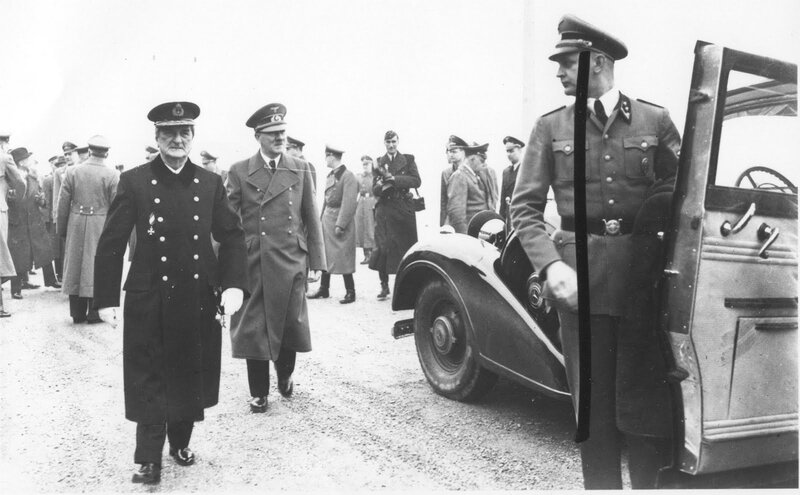
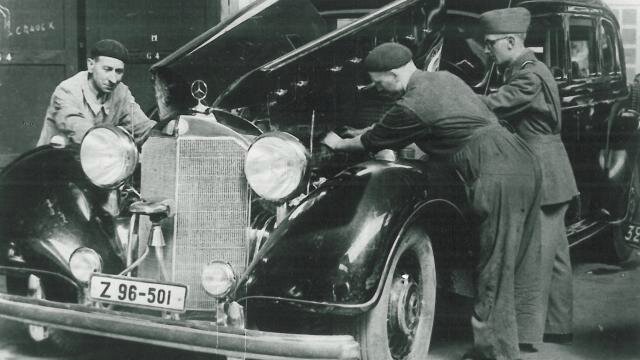
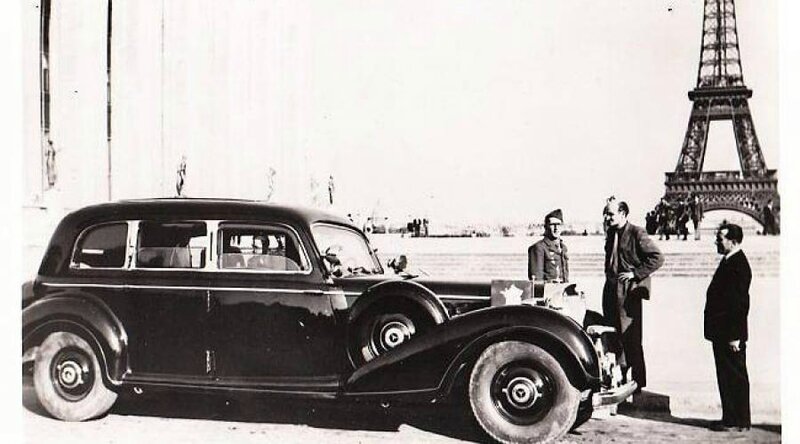
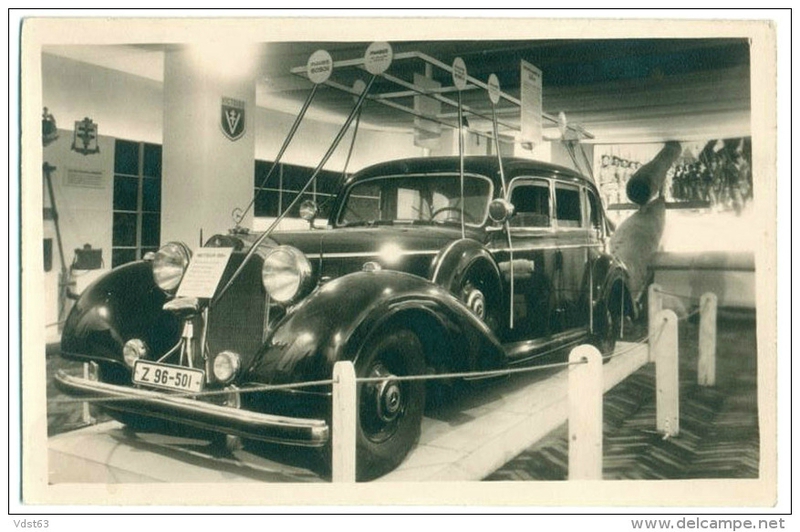





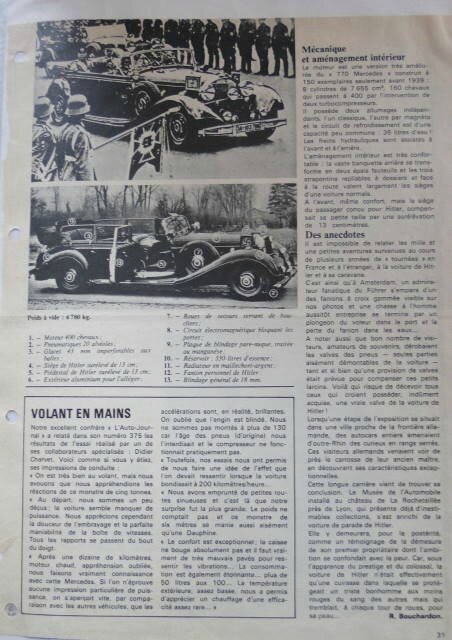


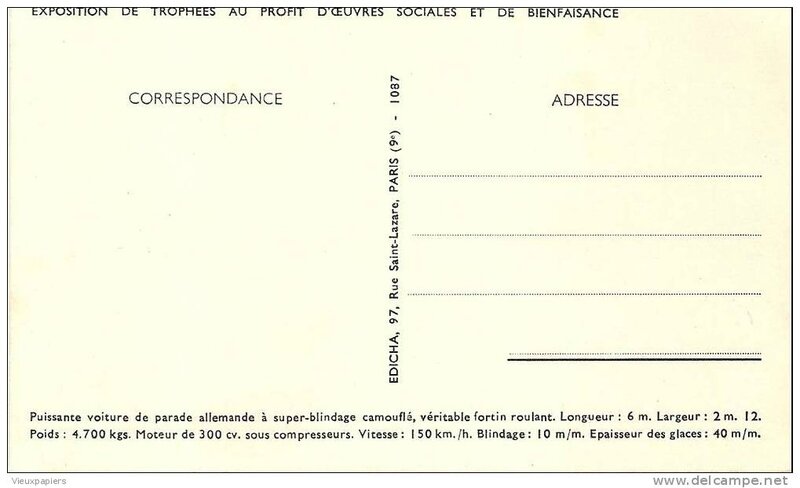

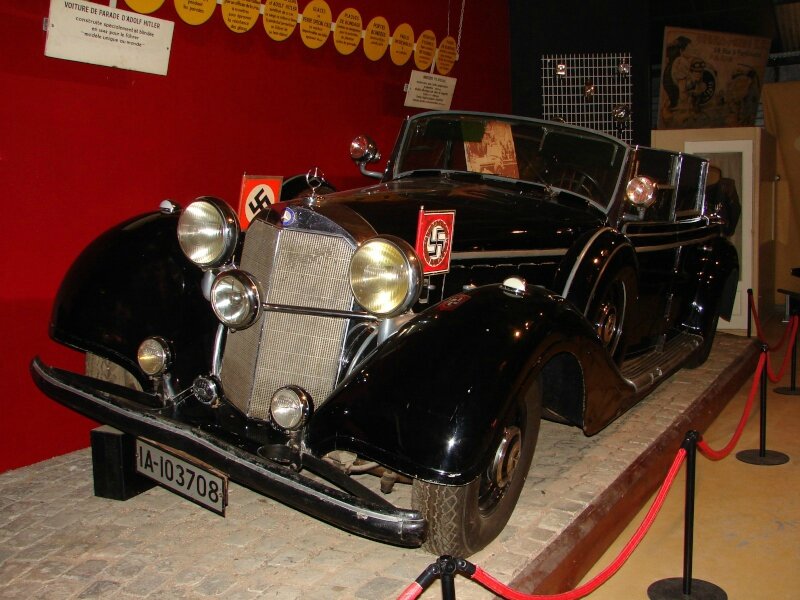
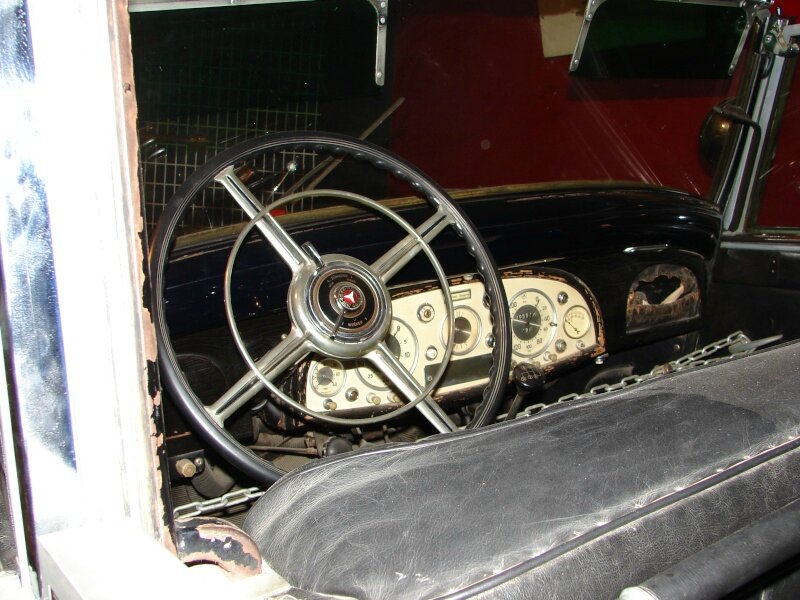
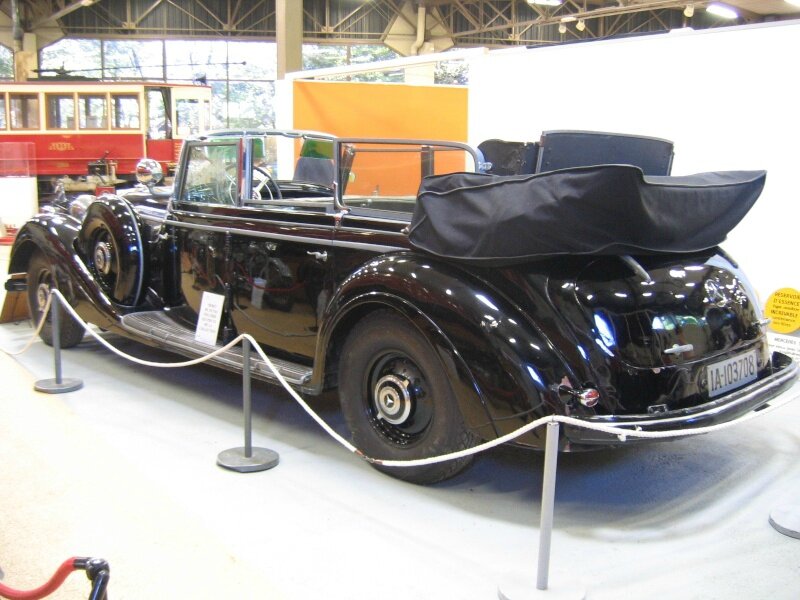



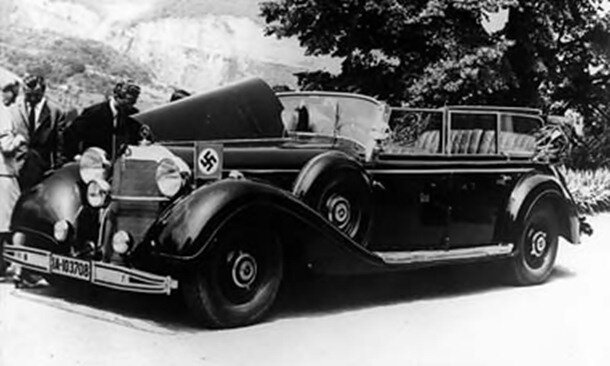


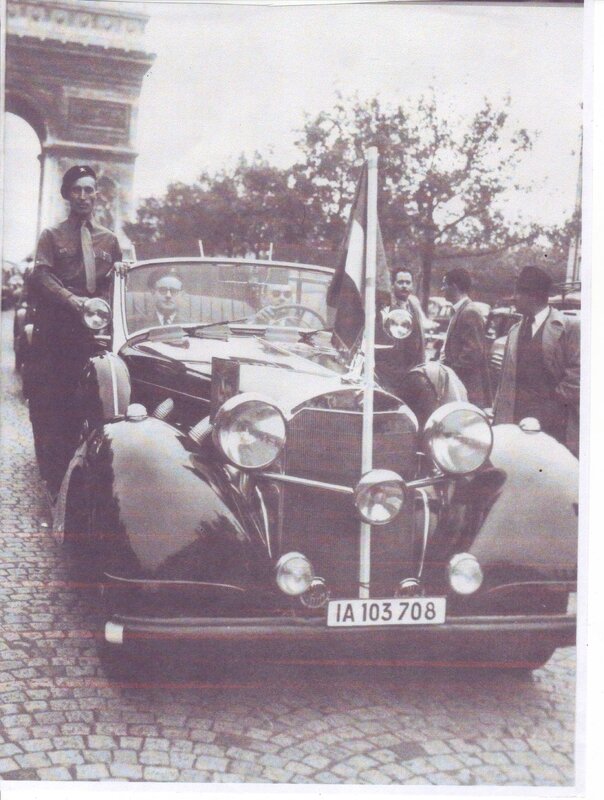
Comment